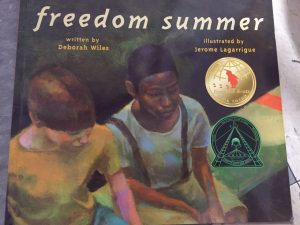
Author: Deborah Wiles
Illustrator: Jerome Lagarrigue
Publishing Information: Aladdin Paperbacks, 2001
Number of Pages: 27
Genre: Historical Fiction, Picture book
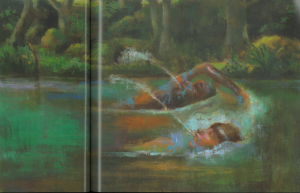

Analysis:
A white boy Joe makes friends with John Henry, the son of the maid of his family. They play together all the time. But there were a lot of laws and rules against black people back then. John Henry cannot get into the store from the front door or swim in the town pool even if he is the finest swimmer. Finally, John Henry decides to use the front door and Joe is right there with him.
The story is based on historical facts. The author grew up in Mobile, Alabama and usually spent her summer with her relatives in Mississippi as she mentioned in the book before she told the story (P. 1). The town pool there was not open to black people. However, when the Civil Rights Act was passed, she witnessed that the town pool was closed. The book serves as a window for children to look back at history and also as a mirror for readers to reflect what is right and what is wrong.
Both of the two characters of this book have strong personalities. John Henry is a nice boy and he would help his mother with her work. In the first half of the book, John Henry does not seem to care whether he could use the front door to the store or whether he could swim in the town pool. He grew up happily playing with Joe and having fun swimming in the creek. But once he realized the difference between rights of white people and rights of himself, he was sad and angry. “John Henry’s eyes fill up with angry tears” (P. 23). The purpose of this book is to expose children to racism. The author tries to convey her point of view that racism is wrong and it can truly hurt feelings of somebody who is so nice. In the book, the author depicts Joe as a sensitive and warmhearted little boy. He would give up going swimming in the town pool just to keep company with John Henry. At the end of the book, Joe and John Henry walked through the front door together. Joe did not ignore the importance of civil rights although he was not directly harmed. He would fight for his friend. He would fight for what is right.
Perceptually, the book uses narrative sentences to tell an engaging story. The whole book uses dark color a lot which conveys a depressing atmosphere. I can find a few bright colors in some of the happy scenes. I found it smart that the illustrator tried to narrow down the difference of Joe and John Henry’s skin colors. Structurally, the text and images are completely separated which helps children to get the story as a whole. Ideologically, this book stresses friendship based on diversity backgrounds. Also, it encourages minorities to stand up for their rights and reminds readers that Civil Rights are universal. It is crucial for everybody to be concerned with it and get involved.

 Pinduli is the story of a beautiful hyena that wanders away from her mother into the East African wild. While Pinduli is wandering she runs into dogs, a lion and a zebra who all judged Pinduli’s looks. Pinduli becomes very self conscience and starts to change her looks to fit in, she gets to the point where she covers herself in dust making her look like a ghost. All the animals that once teased her were now afraid of her and begged her to forgive them for being mean since the believed she was a ghost. Pinduli told them they must find out why they were teasing others and give the one you teased food to be forgiven. Pinduli’s mother found her and reminded her of her inner and outer beauty
Pinduli is the story of a beautiful hyena that wanders away from her mother into the East African wild. While Pinduli is wandering she runs into dogs, a lion and a zebra who all judged Pinduli’s looks. Pinduli becomes very self conscience and starts to change her looks to fit in, she gets to the point where she covers herself in dust making her look like a ghost. All the animals that once teased her were now afraid of her and begged her to forgive them for being mean since the believed she was a ghost. Pinduli told them they must find out why they were teasing others and give the one you teased food to be forgiven. Pinduli’s mother found her and reminded her of her inner and outer beauty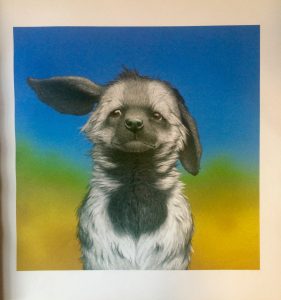
 Tough Guys (Have Feeling Too) is a picture narrative book that talks about how its not always easy being the tough guy and sometimes the guys want people to know that their feelings get hurt too. I believe that this book would be considered a mirror for boys and a window for girls. For boys they see that they aren’t the only ones that get their feelings hurt and that they do not need to be tough all the time. For girls since this book is titled Tough Guys it might be hard for them to connect. Instead they might better relate to a book that talks about how girls are tough too and not always emotional. In the illustrations different races and cultures are represented. Every picture has a male in it and the book does a good job at having them be all different races. There are also different aspects of culture in the illustrations. For example there is a picture of a man in a Lucha Libre uniform which is a type of wrestling that is very popular in Mexican culture. There is also an image of a two men in Tae Kwon Do uniforms, which is a popular and historical Korean activity. Another example is a cowboy and his horseback riding which is a popular American activity. The book shows many different cultures allowing many different people the ability to connect with the text. The images in the text are always going towards the right, which shows that the characters are not as secure, this makes sense that they are all facing the right because all the men feel insecure for having feelings. On the last page there is an image of a father and son and they are facing forward. I took this, as they are content with being able to admit they do have feelings. Since there is minimal text within the book the images make the story interesting and comical but still have a purpose that teaches the lesson that it is okay to show feelings even if you are a tough guy and that you shouldn’t make fun of someone for having feeling. The images are very colorful even when a picture is meant to take place at night, which adds to the lightness of the text. I am unsure if I would use this book in my classroom since only the males in the class would be able to connect due to the lack of females. I wish this text was simply called Everyone Has Feelings and that they showed it is okay for everyone to have feelings to get rid of the negative stereotype that only girls are able to show their emotions.
Tough Guys (Have Feeling Too) is a picture narrative book that talks about how its not always easy being the tough guy and sometimes the guys want people to know that their feelings get hurt too. I believe that this book would be considered a mirror for boys and a window for girls. For boys they see that they aren’t the only ones that get their feelings hurt and that they do not need to be tough all the time. For girls since this book is titled Tough Guys it might be hard for them to connect. Instead they might better relate to a book that talks about how girls are tough too and not always emotional. In the illustrations different races and cultures are represented. Every picture has a male in it and the book does a good job at having them be all different races. There are also different aspects of culture in the illustrations. For example there is a picture of a man in a Lucha Libre uniform which is a type of wrestling that is very popular in Mexican culture. There is also an image of a two men in Tae Kwon Do uniforms, which is a popular and historical Korean activity. Another example is a cowboy and his horseback riding which is a popular American activity. The book shows many different cultures allowing many different people the ability to connect with the text. The images in the text are always going towards the right, which shows that the characters are not as secure, this makes sense that they are all facing the right because all the men feel insecure for having feelings. On the last page there is an image of a father and son and they are facing forward. I took this, as they are content with being able to admit they do have feelings. Since there is minimal text within the book the images make the story interesting and comical but still have a purpose that teaches the lesson that it is okay to show feelings even if you are a tough guy and that you shouldn’t make fun of someone for having feeling. The images are very colorful even when a picture is meant to take place at night, which adds to the lightness of the text. I am unsure if I would use this book in my classroom since only the males in the class would be able to connect due to the lack of females. I wish this text was simply called Everyone Has Feelings and that they showed it is okay for everyone to have feelings to get rid of the negative stereotype that only girls are able to show their emotions.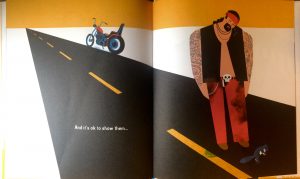
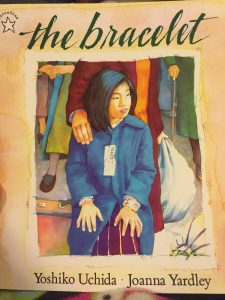
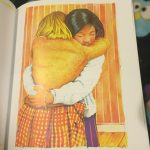
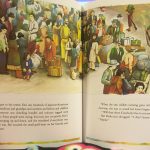

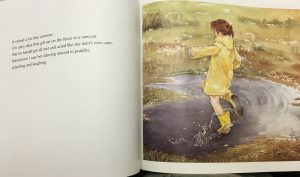 between both girls. As they continue to talk, the girls move closer together. In the story, the fence is a physical barrier between the interaction of the African American and the White populations. It also symbolically represents the barriers that people, especially African Americans, face in their lives. This title, The Other Side, also refers to another aspect of the story. This story features a main character that questions why racism and prejudice are ruling people’s lives. In this case, the character is the person on the other side of the powerful race during this time. This powerful theme carries into other aspects of life. Readers will benefit from the tolerance displayed in the story.
between both girls. As they continue to talk, the girls move closer together. In the story, the fence is a physical barrier between the interaction of the African American and the White populations. It also symbolically represents the barriers that people, especially African Americans, face in their lives. This title, The Other Side, also refers to another aspect of the story. This story features a main character that questions why racism and prejudice are ruling people’s lives. In this case, the character is the person on the other side of the powerful race during this time. This powerful theme carries into other aspects of life. Readers will benefit from the tolerance displayed in the story.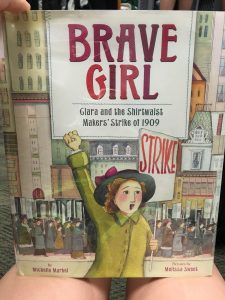 Author: Michelle Markel
Author: Michelle Markel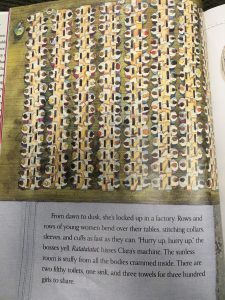 r example, when Clara arrives in America on the boat, the illustrator included an image of the long line of people waiting on the boat for their new life in America. The text is displayed on a stitched piece of fabric that connects to the main theme of the story very well. The pictures are often sewn into the text, making them resemble a quilt. Clara is often found looking or moving to the right of the page, signifying the change that is going to happen. The author uses many adjectives that emphasize the struggles Clara and her colleagues faced. For example, when Clara first arrives, the author introduces her as dirt poor and five feet tall. Ideologically, this story has many things that children can take away after reading. First and foremost, this book gives the students a historical look into the life of immigrants, especially those of women. This book focuses on the hardships and challenges that Clara faced with work and learning to speak English. Secondly, it shows students how important it is to stand up for what they know is right. If Clara were not to stand up for what she believed was right, many workers would have suffered for a longer period of time. Even after Clara faced many arrests, beatings, and threats to be fired, she kept the fight for her rights alive. It proves that determination and perseverance can lead to change for what is right. At the end of the book, readers are introduced to more information about the garment industry that can further their understanding on the topic.
r example, when Clara arrives in America on the boat, the illustrator included an image of the long line of people waiting on the boat for their new life in America. The text is displayed on a stitched piece of fabric that connects to the main theme of the story very well. The pictures are often sewn into the text, making them resemble a quilt. Clara is often found looking or moving to the right of the page, signifying the change that is going to happen. The author uses many adjectives that emphasize the struggles Clara and her colleagues faced. For example, when Clara first arrives, the author introduces her as dirt poor and five feet tall. Ideologically, this story has many things that children can take away after reading. First and foremost, this book gives the students a historical look into the life of immigrants, especially those of women. This book focuses on the hardships and challenges that Clara faced with work and learning to speak English. Secondly, it shows students how important it is to stand up for what they know is right. If Clara were not to stand up for what she believed was right, many workers would have suffered for a longer period of time. Even after Clara faced many arrests, beatings, and threats to be fired, she kept the fight for her rights alive. It proves that determination and perseverance can lead to change for what is right. At the end of the book, readers are introduced to more information about the garment industry that can further their understanding on the topic.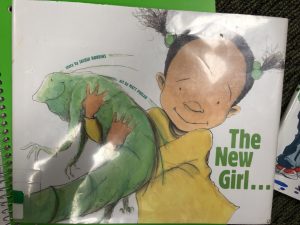
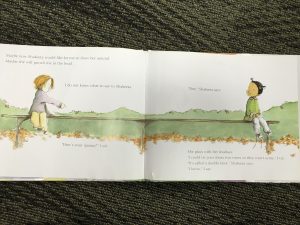

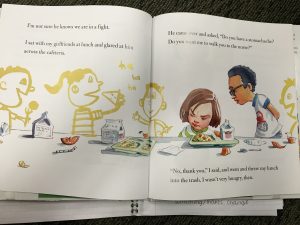 Perceptually, the images are very bright and enticing for the children. The use of faded watercolor pictures, such as in the picture below, allows the focus to remain on the narrator and James. The use of large text in certain areas allows the reader to recognize which points should be emphasized while reading the story aloud. Some of the illustrations resemble the ones that children would draw, making it very relatable for the readers. The layout of the text in relation to the pictures also allows the readers to follow the sequence very well, especially when the author is describing how each classmate heard the rumor about the narrator. Ideologically, this book shows the dangers of gossip and rumors and the effects they have on friendships. The misunderstanding during the “game of telephone” leads to the narrator’s feelings getting hurt by her best friend. Children who read this book are able to see the damage done by gossip and rumors. The ending of the book allows readers to see some things can be misunderstood and taken out of proportion. It also emphasizes the idea of friendship and its importance. The two sided story, the narrator and James’ actions, also show the different emotions when two friends are fighting. This book also gives an example of how children can solve problems with their friends. However, the way in which the narrator reacts is not recommended for children.
Perceptually, the images are very bright and enticing for the children. The use of faded watercolor pictures, such as in the picture below, allows the focus to remain on the narrator and James. The use of large text in certain areas allows the reader to recognize which points should be emphasized while reading the story aloud. Some of the illustrations resemble the ones that children would draw, making it very relatable for the readers. The layout of the text in relation to the pictures also allows the readers to follow the sequence very well, especially when the author is describing how each classmate heard the rumor about the narrator. Ideologically, this book shows the dangers of gossip and rumors and the effects they have on friendships. The misunderstanding during the “game of telephone” leads to the narrator’s feelings getting hurt by her best friend. Children who read this book are able to see the damage done by gossip and rumors. The ending of the book allows readers to see some things can be misunderstood and taken out of proportion. It also emphasizes the idea of friendship and its importance. The two sided story, the narrator and James’ actions, also show the different emotions when two friends are fighting. This book also gives an example of how children can solve problems with their friends. However, the way in which the narrator reacts is not recommended for children.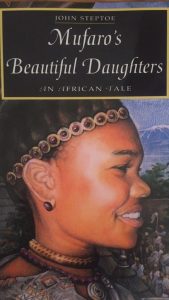
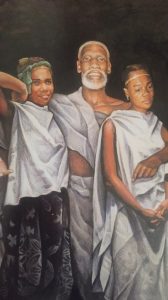
![IMG_9616 [405973]](https://blogs.iwu.edu/lrbmt2016/files/2016/05/IMG_9616-405973-234x300.jpg)
![IMG_9617 [405974]](https://blogs.iwu.edu/lrbmt2016/files/2016/05/IMG_9617-405974-220x300.jpg)